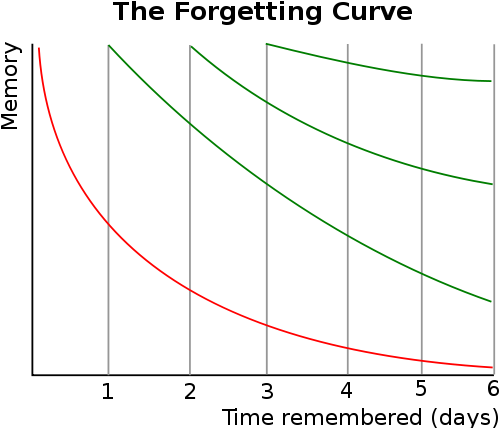Turning information into lasting knowledge is a science. Really remembering something is a science. And like any science, it requires great tools. One of the most effective memorization methods and tools? Spaced repetition. So much in fact that spaced repetition will absolutely be part of the Ninchanese learning experience. Here’s why we love it.
“People need to be reminded more often than they need to be instructed.”
Samuel Johnson, an 18th century English essayist, pinpointed this important fact early on: a key to long term memory retention is being reminded.
Learning is all about retention

When studying, you want to be actually learning and remembering things for a while. So, it’s important to be working on both aspects at the same time. Say, you’re learning Chinese (and we hope you are!). You want to be continuously learning new things, while counteracting the “forgetting curve”.
Ebbinghaus’ forgetting curve
What’s the forgetting curve you ask? Well it has to do with how your memory performs over time and more specifically, how your memory retention declines over time. It was devised by Hermann Ebbinghaus in the 19th century, after he tested his own memory. Crazy! This Wired article explains how intense his experiment was:
“In experiments of breathtaking rigor and tedium, Ebbinghaus practiced and recited from memory 2.5 nonsense syllables a second, then rested for a bit and started again. […] Ebbinghaus trained this way for more than a year.”
Typically, your memory retention declines like this:

The forgetting curve shows the average amount of time it takes you to forget a fact. (c) Wikimedia
Memory decays but you can do something about it
Ok, so my memory decays. Can I do anything about it?
Of course! First, you want a method that teaches you content in the best possible way. A method that ensures optimal short-term memorization. Personally, we’re advocates of the hands-on, active learning approaches. You’re active; you’re engaged; you’re in control of your learning experience because you’re not passively listening to a lecture. Your fire is being lit, as one would say in the 19th century.
Then, you couple this with a method that reminds you of your learning. This gradually shifts what you’ve learned from your short-term memory to mid and long-term memory. Then, the time and effort you’ve spent on training is fully leveraged.
This method should effectively monitor your memory over time (to assess how well or how little you’re remembering an item over time) and prevent decay by re-submitting you the knowledge you’re about to forget, right when you’re about to forget it.
Spaced Repetition System: the best thing that was invented (second only to French Toast)
That method is called the Spaced Repetition System. The basis for this algorithm (Ebbinghaus again) is that each time you successfully encounter a fact, the amount of time it’ll take you to forget the fact again increases. You’re reviewing things at the ideal moment: when you’re on the brink of forgetting them and therefore when you’re most likely to remember those facts.
That way, you’re not wasting time reviewing content you already know; and you don’t forget things because you forgot to think about re-learning them. It’s effective, it’s efficient. And it’s fantastic. Especially for language learners. Even more specifically for Chinese learners, where a lot of the vocabulary acquisition has to do with memorization and not so much with logic.
Because an image speaks louder than words (and because their graph is both clear and pretty nice looking), behold, Wired’s depiction of the SRS:
The video below shows the advantages of the SRS over other memorization methods, in a colored light kind of way. (Start at 2:30 to see the simulations, it’s all text before that)
Okay, this sounds great. But how does this system know when I’m going to forget it?
First of, the optimal moments to be reminded have been carefully and scientifically calculated, based on the spacing effect Ebbinghaus also coined. Those moments are shown in the Wired graph. Those are an integral part of the SRS systems. The system also counts on you to tell it.
Active recall vs. honesty-based recall
In some SRS applications (SuperMemo for instance, from which a lot of the research comes from), you say how well you know the knowledge the system is showing you by rating your knowledge on a scale to one to five. This tells the system where you stand; whether to show you that bit again soon or not so soon.
Personally, we find this leaves room for error. If you’re feeling lazy, you can just click and say “yes, I know this”. It’s pretty easy to cheat the system. Obviously, you’re the one learning, so there’s no reason for you to try to cheat yourself. But still, we feel mankind will try to game the system whenever possible.
Therefore, for us, here at Ninchanese, active recall is the only way to go. The system is the one assessing whether you know or not, not you, based on your answers (and a number of other criteria). You’re being active (here is the active learning principle again!) because you have to come up with the answer yourself; not just say whether you think you know it or not. This is the best way to learn.
That’s the beauty of technology: it helps you become a better you. Well, in this case, it helps you maximize your learning experience. It tells you what to learn and when.This is key to long-term retention.
Ultimately, that’s all you want to get out of learning something. To remember it : Spaced repetition. To be able to use it : Spaced repetition.
The Nincha Team
title photo credit: Flооd via photopin
Ninchanese is a great new app where you’ll have fun learning Chinese. We’re still working on it, so sign up to be invited to the beta when we launch! And stay in touch with us on Facebook, Twitter, Google + and Weibo.






3 comments
Join the conversationOwen Mills - August 9, 2015
Good information. Lucky me I recently found your site by accident (stumbleupon). I’ve saved it for later!
Pingback: New world: The Chinese Character Universe - Science based Chinese characters learning - Ninchanese
Google - November 9, 2018
Wonderful story, reckoned we could combine a couple of unrelated information, nonetheless truly worth taking a look, whoa did a single learn about Mid East has got a lot more problerms as well.
Comments are closed.